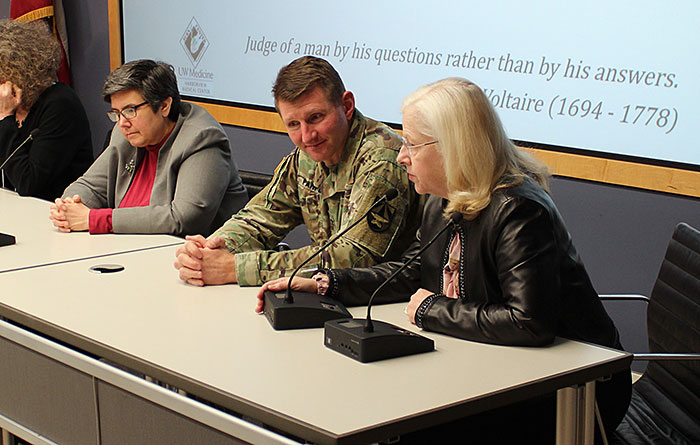Minds Over Matter in Fight to Aid Blast-related Burn Victims

As COL Jeremy Pamplin, Director of the U.S. Army Medical Research and Development Command's (USAMRDC) Telemedicine and Advanced Technology Research Center (TATRC), took to the podium at the Ninth Annual Department of Defense State-of-the-Science Meeting on Blast-related Burn Injury Research on March 3, he pointed to a slide already posted on the projector – a battlefield image showing several Soldiers actively tending to a single, injured Soldier.
"All of these people really should be doing something else," said Pamplin, referring to the huddle.
Those words –said with a wry smile and to the nodding approval of the dozens of attendees gathered at RAND Corporation offices in Arlington, Virginia for the three-day meeting– were Pamplin's way of diving head-first into the complexities of prolonged field care –specifically, caring for Soldiers suffering from burn injuries– on the future battlefield. The topic is fast becoming a key focal point of the entire military medical apparatus.
"Prolonged field care is, in short, treating a patient in a place you know you shouldn't be for longer than you want to be," said Pamplin, placing the concept in general terms. "You have to perform medical care that you would normally perform in a hospital when you're not in a hospital."
To that end, and in reference to his initial comments, Pamplin noted the pressing need for contemporary medical providers to have expertise in a number of critical skill areas prior to aiding Soldiers suffering from burn injuries in a combat zone. The ability to detect serial vital signs and to interpret trends over time (identified as "simple interventions" by Pamplin), the ability to perform prolonged mechanical intervention and airway management ("complex interventions"), and the ability to perform procedures like tube thoracostomies and fasciotomies are integral in such situations, according to Pamplin; efforts that are further enhanced when being performed concurrently by different medical personnel with the goal of saving time. On this subject in particular, Pamplin admitted the need for substantial additional data in the prolonged field care area in order to help prioritize life-saving efforts.
In an almost complementary presentation following Pamplin's talk, Dr. Nicole Gibran of the Department of Surgery at the University of Washington noted the enduring complications that exist for burn patients in the months after their initial injury.
"Burns are not episodic," said Gibran, "rather they are continuing challenges for patients."
While stating she has always been a civilian researcher, Gibran nonetheless noted the similarities that exist among burn patients regardless of where they were injured. While burns have a low overall mortality rate (about 4%), Gibran presented research showing that two years after injury, burn patients experience greater rates of depression, fatigue, and reduced physical function.
"We need to put aside our egos and collaborate," said Gibran, noting that concerns about long-term outcomes exist in both the military and civilian sectors.
That collaboration is taking place both under Pamplin's watch and across the entirety of the USAMRDC. At TATRC, Pamplin is a proponent of telemedicine and other advanced technologies as a means to bridge the resource limitation gap in the field. At the United States Army Institute of Surgical Research (USAISR), researchers collaborating with corporate partners have recently developed the BURNMAN tool –a project that Pamplin initiated while serving at the USAISR– which is a machine-learning algorithm that automatically determines the total body surface area (TBSA) of a burn victim's injuries from a single visual image uploaded to a smartphone or tablet.
For Pamplin, increased training and a focus on emerging technologies is key to winning this particular fight, but it is by no means the final answer.
"You must have resilient providers – providers that think outside of the box," said Pamplin in closing his presentation. "It's a state of mind."














